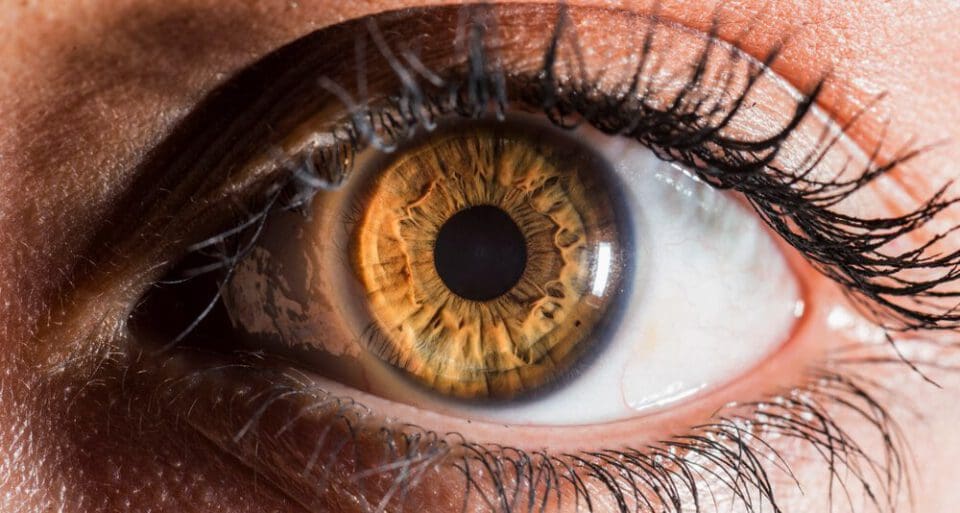
Medically Reviewed by Tom Tooma, M.D., Founder/Medical Director
The Pros & Cons of Different Eye Colors (A Guide)
Home / Vision Education Center /
Last Updated:

Medically Reviewed by Tom Tooma, M.D., Founder/Medical Director
Most people have brown, blue, or hazel eyes, but there are other eye colors too.
Table of Contents
While some mild health benefits and detriments have been linked to eye color, more research is needed. Overall, it is likely that eye color usually has minimal impact on a person’s health.
Two exceptions are albinism, which can cause a person to be significantly sensitive to light, and heterochromia, which is sometimes a sign of more serious health conditions.
The Science Behind Eye Color
Many people believe eye color is determined solely by a single gene, even having been taught as much in school.
The common misconception, once believed as fact by scientists, is that eye color was determined by one gene that expressed as brown (a dominant gene) or blue (a recessive gene). But we now know it is much more complicated than this.
You deserve clear vision. We can help.
With 135+ locations and over 2.5 million procedures performed, our board-certified eye surgeons deliver results you can trust. Your journey to better vision starts here.

A person’s eye color is actually an expression of dozens of genes (over 60, according to one study). Even among people with the “same” eye color, such as blue, these genes can create subtle differences that mean your eye color is as unique as your fingerprints.
The actual pigment that gives the eye color is called melanin, which darkens your eye color. The gene groupings that cause your eye to have more melanin are the most common, which is why brown is the most common eye color. Brown was also the first eye color in human beings, with the rest coming later as genetic mutations.
The Most Common Eye Colors
Brown is the most common eye color both worldwide and in the United States, with more than half of people in the world having brown eyes. Because of where later genetic mutations originated, lighter eye colors almost exclusively exist among populations with European ancestry.
Brown eyed-genes are also generally dominant, meaning a person with brown eyes who produces a child generally has a greater than even chance of producing a child who also has brown eyes.
The second most common eye color is blue, with an estimated 17 percent of the world’s population having blue eyes. Blue-eyed genes are generally recessive.
It was once believed two blue-eyed people could not produce a brown-eyed child, meaning it was previously thought it might be a sign of infidelity if a child attributed to such a couple had brown eyes. This is not valid, and the reality is more complicated. It isn’t common for two blue-eyed parents to produce a brown-eyed child, but it is possible.

The Rarest Eye Colors
When discussing rare eye colors, it is common for people to bring up other colors they’re likely to have still seen in the general population of their community or at least on television. Eye colors such as green and hazel are rare but they aren’t actually the rarest.
The rarest eye colors are the result of extremely uncommon genetic mutations. For example, a mutation in the FOXC2 gene is thought to be the reason some people are born with violet eyes.
Another rare eye color, which might be called pink or red, is the result of albinism. A person born with albinism has almost no melanin in their skin, hair, and irises. In addition to giving a person naturally very pale skin and bright blonde or white hair, this also means their eyes have an unusual reddish or pinkish hue, although this unfortunately has the side effect of making them very sensitive to sunlight.
Heterochromia
Some people are born with or develop a condition called heterochromia. This is when a person has a different eye color in each eye, most commonly brown and blue.
Some people develop heterochromia as a result of injury or another eye health complication. If a child or adult develops heterochromia, they should see an ophthalmologist, as it can sometimes signal more serious health complications.
However, heterochromia usually isn’t serious and requires no treatment on its own if no other health conditions are detected.
You deserve clear vision. We can help.
With 135+ locations and over 2.5 million procedures performed, our board-certified eye surgeons deliver results you can trust. Your journey to better vision starts here.
The Eye Color Spectrum
Eye colors, like all colors, exist on a spectrum. In addition to broad color categories like blue or brown, eye colors can also be different shades.
A person’s eyes might be one of virtually infinite shades, many very difficult to distinguish from each other, depending on the specifics of their genetics.
Do Different Eye Colors Have Different Benefits?
Because of the sometimes simplified way concepts like genetics and Darwinism are taught, we might reasonably assume there is a survival-based reason various eye colors developed and survived in various human populations. While research is ongoing, this doesn’t seem to be the case.
Of all eye colors, brown seems to be the only one that could be called “advantageous” from a survival perspective. While more research is needed, darker irises are linked to a number of health benefits, including these:
- Reduced risk of macular degeneration
- Lower melanoma risk
Lighter eyes may have some advantages too, but they are also linked to certain health and addiction risks. People with lighter eyes may have the following:
- A lower chance of developing vitiligo
- A higher risk of abusing alcohol
- Greater light sensitivity, especially among people with albinism
Notably, the potential differences in health impacts between different eye colors are almost certainly slight. The reason different eye colors have managed to survive is largely because they didn’t significantly impact the survivability of the early humans who developed them.
Most potential benefits that might come from eye color are social. Some people find different eye colors more attractive or interesting. Different eye colors also make humans more diverse, which is arguably a positive where it doesn’t significantly impact health.
Human Eye Color Chart
The following is a chart listing the estimated rate of each eye color in the general population. Note that because eye color is genetic, the specific ratio of eye color in a given community can vary significantly from these numbers:
| Color | Rate of Occurrence |
|---|---|
| Brown | >50% |
| Blue | ~8% – 10% |
| Hazel | ~5% |
| Green | ~2% |
| Gray | Unknown (<1% – ~3%) |
| Red/Pink | Unknown (<1%) |
| Violet | Unknown (<1%) |
You deserve clear vision. We can help.
With 135+ locations and over 2.5 million procedures performed, our board-certified eye surgeons deliver results you can trust. Your journey to better vision starts here.
References
- 4 Things Your Eye Color Might Reveal About Your Health. (January 2020). The Healthy.
- Eye Color: Unique as a Fingerprint. (December 2017). American Academy of Ophthalmology.
- Heterochromia. (April 2021). American Academy of Ophthalmology.
- Is Eye Color Determined By Genetics? MedlinePlus.
- Rare Eye Colours You Didn’t Know About. (October 2021). Feel Good Contacts.
- This Is Exactly How Many People Have Blue Eyes. (December 2018). Yahoo.
- What Colour Are Your Eyes? Teaching the Genetics of Eye Colour & Colour Vision. Edridge Green Lecture Rcophth Annual Congress Glasgow. (May 2019). Nature.
- Your Eye Color, Explained. (February 2022). Discover.
- Is Eye Color Genetic? | What Your Eye Color Has to Do With Your History. (June 2019). Luna.
- True Colors: A Literature Review on the Spatial Distribution of Eye and Hair Pigmentation. (March 2019). Forensic Science International: Genetics.

Dr. Tooma, the founder of NVISION® Eye Centers, has performed well over 130,000 LASIK surgeries, making him the most experienced LASIK surgeon in the Western United States.
This content is for informational purposes only. It may have been reviewed by a licensed physician, but is not intended to serve as a substitute for professional medical advice. Always consult your healthcare provider with any health concerns. For more, read our Privacy Policy and Editorial Policy.